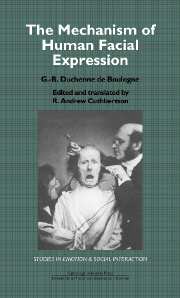Book contents
- Frontmatter
- Contents
- Acknowledgments
- Contributors
- Editor's Preface
- Part 1 The mechanism of human facial expression or an electrophysiological analysis of the expression of the emotions
- Preface
- A Introduction
- B Scientific section
- Foreword
- Chapter 5 Anatomical preparations, and portraits of the subjects who underwent electrophysiological experiments
- Chapter 6 The muscle of attention (m. frontalis)
- Chapter 7 The muscle of reflection (superior part of m. orbicularis oculi, that part of the muscle called the sphincter of the eyelids)
- Chapter 8 The muscle of aggression (m. procerus)
- Chapter 9 The muscle of pain (m. corrugator supercilii)
- Chapter 10 The muscles of joy and benevolence (m. zygomaticus major and the inferior part of m. orbicularis oculi)
- Chapter 11 The muscle of lasciviousness (transverse part of m. nasalis)
- Chapter 12 The muscle of sadness (m. depressor anguli oris)
- Chapter 13 The muscles of weeping and whimpering (m. zygomaticus minor and m. levator labii superioris)
- Chapter 14 The muscles complementary to surprise (muscles that lower the mandible)
- Chapter 15 The muscle of fright, of terror (m. platysma)
- Chapter 16 A critical study of several antiquities from the point of view of m. corrugator supercilii and m. frontalis
- C Aesthetic section
- Part 2 Commentary chapters
- Index
Chapter 10 - The muscles of joy and benevolence (m. zygomaticus major and the inferior part of m. orbicularis oculi)
Published online by Cambridge University Press: 10 November 2010
- Frontmatter
- Contents
- Acknowledgments
- Contributors
- Editor's Preface
- Part 1 The mechanism of human facial expression or an electrophysiological analysis of the expression of the emotions
- Preface
- A Introduction
- B Scientific section
- Foreword
- Chapter 5 Anatomical preparations, and portraits of the subjects who underwent electrophysiological experiments
- Chapter 6 The muscle of attention (m. frontalis)
- Chapter 7 The muscle of reflection (superior part of m. orbicularis oculi, that part of the muscle called the sphincter of the eyelids)
- Chapter 8 The muscle of aggression (m. procerus)
- Chapter 9 The muscle of pain (m. corrugator supercilii)
- Chapter 10 The muscles of joy and benevolence (m. zygomaticus major and the inferior part of m. orbicularis oculi)
- Chapter 11 The muscle of lasciviousness (transverse part of m. nasalis)
- Chapter 12 The muscle of sadness (m. depressor anguli oris)
- Chapter 13 The muscles of weeping and whimpering (m. zygomaticus minor and m. levator labii superioris)
- Chapter 14 The muscles complementary to surprise (muscles that lower the mandible)
- Chapter 15 The muscle of fright, of terror (m. platysma)
- Chapter 16 A critical study of several antiquities from the point of view of m. corrugator supercilii and m. frontalis
- C Aesthetic section
- Part 2 Commentary chapters
- Index
Summary
Plates 30, 31, 32, 33, 34, 35, 36
(Compare alternately the two sides of Plates 30, 35 and 36, by masking the opposite side.)
Plate 30: To study the fundamental and secondary expressive lines produced by the contraction of m. zygomaticus major in an old man (shown also in Plates 3, 6, 7, 8, 9, 12, 13, 14, 17, 18, 19, 20, 21, and 22). On the right, electrical excitation, which is strong but quite limited to m. zygomaticus major, showing development of the fundamental and secondary lines of this muscle: false joy or laughter. On the left, a relaxed face.
Plate 31: Slightly stronger electrical excitation of both mm. zygomaticus major: development of the same fundamental and secondary expressive lines of joy, with mild contraction of some fibers of the muscle called the sphincter of the eyelids: false laughter.
Plate 32: The same subject as in Plates 30 and 31, showing that natural laughter really is constituted by the association of m. zygomaticus major and the inferior part of m. orbicularis oculi. Natural laughter, by the voluntary contraction of the two mm. zygomaticus major and of the inferior part of mm. orbicularis oculi.
Plate 33: The same subject, showing that the wrinkles radiating from the lateral canthus of the eyelids, due to the action of mm. zygomaticus major, disappear when mm. frontalis is stimulated at the same time. Maximal stimulation of mm. zygomaticus major and of mm. frontalis: a false incomplete expression of agreeable surprise, or admiration. […]
- Type
- Chapter
- Information
- The Mechanism of Human Facial Expression , pp. 69 - 73Publisher: Cambridge University PressPrint publication year: 1990



